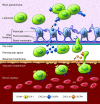Trafficking of immune cells in the central nervous system
- PMID: 20440079
- PMCID: PMC2860945
- DOI: 10.1172/JCI41911
Trafficking of immune cells in the central nervous system
Abstract
The CNS is an immune-privileged environment, yet the local control of multiple pathogens is dependent on the ability of immune cells to access and operate within this site. However, inflammation of the distinct anatomical sites (i.e., meninges, cerebrospinal fluid, and parenchyma) associated with the CNS can also be deleterious. Therefore, control of lymphocyte entry and migration within the brain is vital to regulate protective and pathological responses. In this review, several recent advances are highlighted that provide new insights into the processes that regulate leukocyte access to, and movement within, the brain.
Figures



Similar articles
-
The blood-central nervous system barriers actively control immune cell entry into the central nervous system.Curr Pharm Des. 2008;14(16):1555-65. doi: 10.2174/138161208784705432. Curr Pharm Des. 2008. PMID: 18673197
-
Immune regulation within the central nervous system.J Neurol Sci. 1998 Apr 15;157(1):1-12. doi: 10.1016/s0022-510x(98)00049-5. J Neurol Sci. 1998. PMID: 9600670 Review.
-
The ins and outs of T-lymphocyte trafficking to the CNS: anatomical sites and molecular mechanisms.Trends Immunol. 2005 Sep;26(9):485-95. doi: 10.1016/j.it.2005.07.004. Trends Immunol. 2005. PMID: 16039904 Review.
-
Immune cell migration as a means to control immune privilege: lessons from the CNS and tumors.Immunol Rev. 2006 Oct;213:195-212. doi: 10.1111/j.1600-065X.2006.00433.x. Immunol Rev. 2006. PMID: 16972905 Review.
-
Regulation of immune cell entry into the central nervous system.Results Probl Cell Differ. 2006;43:259-80. doi: 10.1007/400_020. Results Probl Cell Differ. 2006. PMID: 17068976 Review.
Cited by
-
Depleting tumor-specific Tregs at a single site eradicates disseminated tumors.J Clin Invest. 2013 Jun;123(6):2447-63. doi: 10.1172/JCI64859. J Clin Invest. 2013. PMID: 23728179 Free PMC article.
-
Melanoma brain metastases have lower T-cell content and microvessel density compared to matched extracranial metastases.J Neurooncol. 2021 Mar;152(1):15-25. doi: 10.1007/s11060-020-03619-0. Epub 2020 Sep 24. J Neurooncol. 2021. PMID: 32974852 Free PMC article.
-
Neuropharmacologic Approaches to Restore the Brain's Microenvironment.J Neuroimmune Pharmacol. 2016 Sep;11(3):484-94. doi: 10.1007/s11481-016-9686-5. Epub 2016 Jun 28. J Neuroimmune Pharmacol. 2016. PMID: 27352074 Free PMC article. Review.
-
Cell trafficking through the choroid plexus.Cell Adh Migr. 2012 Sep-Oct;6(5):390-6. doi: 10.4161/cam.21054. Epub 2012 Aug 20. Cell Adh Migr. 2012. PMID: 22902764 Free PMC article.
-
Timing and type of immune checkpoint therapy affect the early radiographic response of melanoma brain metastases to stereotactic radiosurgery.Cancer. 2016 Oct;122(19):3051-8. doi: 10.1002/cncr.30138. Epub 2016 Jun 10. Cancer. 2016. PMID: 27285122 Free PMC article.
References
-
- Ehrlich P.Das sauerstufbudurfnis des organismus. Eine Farbenanalytische Studie . Berlin, Germany: Hirschwald; 1885.
-
- Goldmann EE. Vitalfarbung am zentralnervensystem. Abhandl Konigl preuss Akad Wiss. 1913;1:1–60.
-
- Ge S, Song L, Serwanski DR, Kuziel WA, Pachter JS. Transcellular transport of CCL2 across brain microvascular endothelial cells. J Neurochem. 2008;104(5):1219–1232. - PubMed
Publication types
MeSH terms
Substances
Grants and funding
LinkOut - more resources
Full Text Sources
Other Literature Sources
Medical

